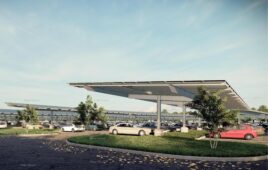California on Thursday is expected to announce it will ban all new gasoline-powered automobiles by 2035, according to The New York Times.
The ambitious plan to eliminate greenhouse gas emissions from tailpipes was welcomed by clean energy and climate advocates. It will be a critical move as California and other states rush to adopt policies to stave off the worst impacts of the climate crisis.
Transportation is the leading contributor to climate pollution in the U.S. So it is critical that auto industry and policymakers make the investments needed to increase the number of electric vehicles on the road while also making sure they are financially accessible to working- and middle-class families.
But it will be a complex policy to implement.
One of the most pressing challenges the administration of Gov. Gavin Newsom and future leaders will face is making sure there is enough power to charge all the new electric automobiles that will fill driveways, garages and parking lots throughout the most populous state in the country. The new demand can only be met by dramatic expansions to rooftop solar.
“The ambitious plan to ban the sale of new gas-powered cars is exactly the kind of climate solutions California and the rest of the country should be adopting,” said EWG President and Bay Area resident Ken Cook. “But it will require the state to dramatically ramp up investments in residential and commercial solar that will be needed to charge the millions of electric vehicles in the coming decade. I don’t see how Gov. Newsom can achieve what his administration would like to do on clean transportation without the most robust rooftop and community solar programs the state can support.”
There are now more than 1.3 million households, schools and small businesses taking part in the state’s popular rooftop solar program. But at the same time, the California Public Utilities Commission will soon release its proposed decision on NEM 3.0 that could result in lower compensation and additional grid-use charges for residential solar customers.
According to data collected from the U.S. Dept. of Energy and analyzed by the electrek, there are already more than 560,000 electric vehicles registered in California. With the state’s population reaching 40 million, the coordinated planning required to reach the 2035 goal is a huge undertaking and will require an all-in approach.
News item from the Environmental Working Group





This whole mandate madness in California is a dysfunctional attempt at “Social Engineering” at a manic rate. The way things are going now, California has about 25 million acres of land that still ‘hasn’t’ burned yet. Over the next say 10 to 15 years as this fuel catches fire and burns off, sooner or later there will be much less to burn and emissions and PPM 2.5 ash should allow air quality to rebound. The problem taking the lack of burnable fuel in California will be paraded around like the SCAQMD and CARB are actually “worth something”. Right now, those folks that will stay in California, ‘no matter what’ will look to solar PV and smart ESS to help them get through a terrible time in California’s History of geopolitical plight. I can see a group getting together for a class action lawsuit in California against the CPUC, three major rote IOU electric Utilities and it might spill over to include the CEC as defendants that will be required to justify the path they have taken, the costs foisted on the ratepayer public for all of the State.